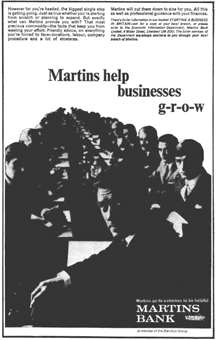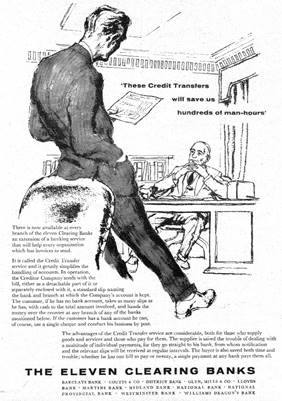|
|

![]()
|
MARTINS BANK AT YOUR SERVICE –
BUSINESS BANKING |
|
It takes decades for many of the UK’s clearing
banks to package products specifically aimed at businesses, large and
small. Dedicated face to face staff
are first made available to PERSONAL
CUSTOMERS by
Barclays from the late 1970s, but it takes longer for a business or corporate
equivalent to emerge. In the case of banks who, like Martins and Barclays
operate a decentralised
service - with district or local head offices – the trends in local
business are picked up and dealt with according to local need.
Decentralisation is a source of pride for decades, as top down decisions are
by-passed by a team of people who know the local area and its business
needs. Until banking becomes more and
more streamlined, and the idea takes hold that wherever you are as a customer
you should be treated in the same
way as everyone else, there is no definable pattern of service or
products available to business customers.
We must look to Martins’ own business advertising for clues, where we
find that foreign trade is a pre-occupation for many years… |
||||||
|
|
|
|||||
|
Images © 1939 Barclays (Left) and 1945 © Martins Bank Archive Collections (Above and below)
|
||||||
|
From here on,
the importance of exporting goods will never be far from the minds of
governments, businesses and the banking sector. Whether through adverts like these, initiatives
such as National Productivity year, or the “I’m Backing Britain” campaign of
the late 1960s, the need to trade with the World is always being pushed, and
pushed hard. “The World is your
Market” was another of Martins Bank’s indispensible guides for business that
was available to customers and non-customers for a number of years. See also AGRICULTURAL
BANKING.
|
||||||
|
|
|
|
||||
|
The World is Your Market becomes an important annual publication |
The 1960s brings a new urgency to exporting with “National Productivity Year” (1963) |
|||||
|
Images © Martins Bank Archive
Collections
National Productivity Year and beyond…
1965 onwards: Starting or building a business |
||||||
|
|
|
|
||||
|
Images © Martins Bank Archive
Collections
|
||||||
|
The introduction by the eleven
clearing Banks of the Credit Clearing system in 1962 paves the way for
smoother business transactions, and the ability to pay employees directly
into their own Bank Accounts. Martins Bank’s Advertising is based around the
success of its Information Department, whose perhaps unrivalled collective
knowledge produces literature that is of practical help to those already in
business and those who are just starting up.
The bank can also take pride in its decentralised structure, with
local head offices around the country able to make important decisions
without keeping the customer waiting.
Image © Martins Bank Archive
Collections
Image © Martins Bank Archive
Collections |
Image © Martins Bank Archive
Collections
Image © Barclays Ref 0025-0658-0005 |
|||||
|
As the swinging
sixties progress, EXPORTS are key both to
the success
The front cover
of The World is Your Market even features in the pages of Martins Bank’s
Annual Report and Accounts for 1960, which shows the commitment the Bank has
made to helping businesses succeed at home and abroad. Backed by the
expertise of Martins Overseas Branches at Liverpool Manchester and London,
The World is Your Market continues to be a successful publication right up to
the merger with Barclays…
So much for
small to medium business – Martins Bank also looks after the banking needs of
some VERY large business concerns, and we look in detail at this, and at how
it leads to the merger with Barclays in our CORPORATE
BANKING feature. We also examine Barclays’ own proposals for a
merger with Martins AND Lloyds Bank, and also at what might have been if
Martins Bank had survived into the twenty-first Century.
|
||||||
<,

















